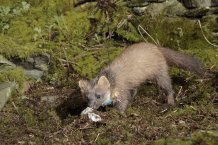Articles

Female pinemarten with radio collar - copyright Nick Upton
Pine martens like to have neighbours – but not too near
Pine martens need neighbours but like to keep their distance, according to new research.
Over three years, the cat-like predators were caught in Scotland and moved to mid-Wales by Vincent Wildlife Trust.
By attaching miniaturised radio-transmitter collars to 39 of the released animals, a tracking team followed them for a year as they explored their new home in Welsh forests.
The research, published today in the journal Ecology and Evolution, was carried out by Dr Cat McNicol from the Environment and Sustainability Institute of the University of Exeter with staff from Vincent Wildlife Trust.
Dr McNicol’s analyses have shown that the pine martens spent some time exploring their new habitats before settling into solitary territories, but that having pine marten neighbours helped them settle more quickly.
In the first release, when there were no other pine martens nearby, the new arrivals roamed long distances over two weeks before settling into their chosen territory – often close to the point where they were released.
The following year, when more pine martens were released in the same area, the new cohort established territories within a week, but further away from the release point.
Dr McNicol said “Although they defend solitary territories vigorously, pine martens depend on their neighbours when deciding where to set up home. Releasing martens near to others promoted rapid settlement. Using scent-marking as their main way of communication, newly-released martens can figure out which bits of woodland are occupied by other individuals and then set up home nearby. This behaviour results in a patchwork-quilt of new territories spreading across the Welsh countryside.”
Although smaller than a domestic cat, pine martens are highly mobile, and the tracked animals had an average range of 9.5 km2 (about 2350 acres).
The Scottish martens and their descendants are now thriving in Wales, where they are living and breeding in woodland habitats, mainly eating voles and mice.
The new arrivals are also tucking into grey squirrels.
In a separate study published in the Journal of Applied Ecology and funded by The Forestry Commission, Dr McNicol attached similar tracking collars to squirrels as the pine martens were introduced.
She found that resident grey squirrels increased their ranging behaviour significantly in the presence of pine martens.
“The martens created a ‘landscape of fear’ for the grey squirrels, changing their behaviour to avoid predation,” Dr McNicol said.
The finding adds to a growing body of research showing that pine martens could have a negative impact on grey squirrels – which is good news for foresters and woodland owners.
Date: 15 May 2020
